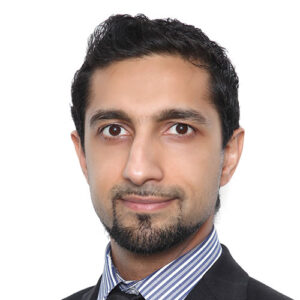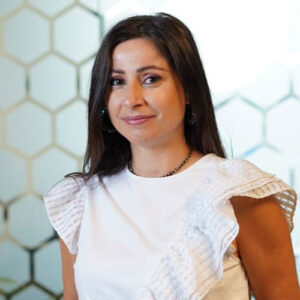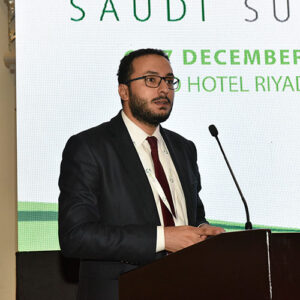‘Even in the most liberal economies, some strategic sectors remain under governmental control. Energy – whether renewable or not – is one of them,’ says Philippe Sébille-Lopez (Géopolia). ‘Each sovereign country can administer the industry freely within the limits of international law and of potential self-binding commitments; the EU being a specific case due to its natural gas and power common markets, on which special regulations on external supplies apply’ he continues.
In fact, Norma Akoury (TotalEnergies) explains, ‘despite the similarities between GCC countries, there are obvious disparities in the different national regulations in the region.’
She agrees with Marthinus Vermeulen (OilSERV) that the UAE and Saudi Arabia have ‘a clear and very exhaustive regulatory framework [supported by policies, incentives, certifications, partnership with research institutions, and suitable infrastructure]. Unsurprisingly, it is in these jurisdictions that large renewables projects are being undertaken.’
Ahmed Samir Elbermbali, Managing Director at the Abu Dhabi-headquartered Clean Energy Business Council (CEBC) and Sebastien Bernard, Head of Legal (Project Development and Project Finance) at EDF Renewables Middle East, go further. They agree that these two countries will dominate the regional market leaders in the years to come.
When it comes to drafting regulations, Saudi Arabia and the UAE have two main common denominators.
The first, observes Monica Hashemi (Dii Desert Energy), is their ‘determination to find a balance between control and laissez-faire so they can keep the energy sector under governmental supervision and yet attract the companies and investors that will help them shape their economic and energetic future.’
The second, Marthinus Vermeulen says, is their overall versatility. ‘In the fourth quarter of 2020 alone, the UAE and Saudi Arabia each published half a dozen laws to address current economic developments. They are not limited to the environment and ESG – in fact, they relate to matters as different as data privacy, labour law and crypto currencies – but this shows their intention to draw innovation and adapt their legislation in accordance with a fast-evolving market.’
On this specific part of the normative landscape, Marthinus Vermeulen continues ‘ESG requirements are categorically imposed on public listed companies in the UAE and Saudi. Particularly, they are required to submit sustainability reports. The next possible regulatory step may most likely be to extend these expectations to all private companies as well.’
What to expect in terms of hydrogen regulation?
In 1990, the International Organization for Standardization (ISO) established a committee dedicated to hydrogen technologies, with the intention of producing standards for the production, storage, transport, and use of hydrogen.
In 2020, the European Commission issued the EU Strategy relating to the implementation of the EU Green Deal. The policy includes specific sections about hydrogen, making it a key component in its pivot to climate neutrality by 2050. Australia had a similar approach in 2019, when it released its National Hydrogen Strategy, and so did Japan in 2017, with its Basic Hydrogen Strategy, and the additional objective of becoming the world’s ‘first hydrogen society’. These frameworks have specific emphasis on increasing the hydrogen demand and the construction of hydrogen stations by the time hydrogen technology is deemed to have reached full efficiency.
With the enormous potential hydrogen has in the Gulf region, the upcoming regulatory framework is expected to support research and production, develop standardisation and transport infrastructure, and to foster the creation of bilateral or multilateral agreements with export markets.
‘However,’ he adds, ‘when it comes to renewables, regulations across the region are not particularly pressing. The main noticeable emphasis is on procurements. Public renewable energy procurers, like the Emirates Water and Electricity Company (EWEC) in Abu Dhabi, the Public Renewable Energy Projects Development Office (REPDO), which belongs to the Ministry of Energy in Saudi, or the Oman Power and Water Procurement Company (OPWP) in Oman, have for instance set up rules, with regards to procurement, which apply to the way renewable energy projects are procured and the project documents (such as the power purchase agreement) are drafted.’
In addition to these actors, each country has a designated regulator. ‘Nonetheless,’ Sebastien Bernard continues, ‘regulators, whether the Regulation and Supervision Bureau for Electricity and Water (RSB) in the UAE, the Authority for Electricity Regulation (AER) in Oman, or the Water and Electricity Regulation Authority (WERA) in Saudi Arabia, focus their attention on procurements. More specifically, I have noticed an effort to regulate public tendering and procurement processes.’ In particular, countries now publish tenders and procurement opportunities and regulations on dedicated online portals to enhance transparency, avoid corruption and maximise efficiency.
Ahmed Samir Elbermbali confirms Sebastien Bernard’s outlook, however. ‘Rather than having dedicated sets of regulations, laws and decrees that would apply to specific sources of energy or utilities, GCC countries have produced sets of intellectual frameworks that allows flexibility for the stakeholders of the renewables industry.’
‘GCC countries are creating the kind of ecosystem they need to increase business and investment opportunities,’ Ahmed Samir Elbermbali concludes.
GCC countries have indeed resorted to an ecosystem-based approach to diversifying their strategic effort to energy. This shift required the adoption of sustainable practices and sustainable growth in all sectors within each country. Efforts of this kind allow a country to increase its visibility and attractiveness on a global scale. These countries have also developed their ecosystem with the objective to prevent market volatility, improving their economic, political and social disposition, and ultimately encouraging the increase of business for all stakeholders.
GCC countries which embark on diversifying their economy to create an investment-ready ecosystem, are likely to encourage and build an impressive investment resume for the future. They have opted for a holistic approach, seeking alternative economic development options for other sectors of their economies, such as in tourism, general industry, infrastructure, sports and ICT, while harnessing foreign investment and developing local businesses.
Thus, GCC countries are establishing their own potential to capture more foreign direct investment as they diversify.
FDI ABCs in GCC: A Foreign Direct Investment Guide
Both the UAE and Saudi Arabia started to implement their plans to reach their energy strategy plans in 2018, with consequences on foreign direct investment (FDI), financing and access to the market in particular.
‘In this part of the world, FDI has long been closely monitored,’ says Mohammed Atif (DNV Dubai), ‘but there have been substantial changes in the past few years.’
In 2019, the UAE government allowed energy and large utilities projects to be fully owned by foreign nationals. ‘The spirit of this legislation was to attract solar panels and green energy investors, but it actually encompasses all renewables,’ Mohammed Atif explains.
‘The Saudi government took a similar decree in 2018 and Oman in early 2020,’ Sebastien Bernard (EDF Renewables) imparts. ‘As electricity is a Strategic and protected sector, companies still need to obtain specific licenses from the relevant local regulatory authorities, but these measures have clearly boosted the industry throughout the GCC.’
According to Norma Akoury (TotalEnergies), ‘these changes in FDI norms have greatly eased the setting up process for companies.’
Historically, corporations have had to settle in one of the many regional free zones for a buffer period. Free zones were created in 1985 in Abu Dhabi and were, for a long time, a remedy to the restrictions of the local federal laws that could not adapt fast enough to the market requirements. Therefore, free zones helped companies to grow and expedite their settlement more efficiently. ‘Under the new frameworks,’ Nadine El Gemayel (VWT) explains, ‘free zones do not necessarily make things a lot easier for renewable energy companies. Regulations are issued to welcome investors and other actors, with the stated purpose to facilitate business, whether in the free zones or mainland, including the setting up of renewable energy companies.’
‘An advantage of the free zones is that they allow common law judiciary courts, such as the ones based in the Dubai International Financial Centre. The courts are independent and use the English language, but in all GCC countries, they are contractually accessible from mainland,’ Nadine El Gemayel continues. ‘Therefore, these alternative jurisdictions, although they can help clarify business relations with or between foreign companies, are not necessarily better, not worse than local courts.’
Onshore, though parties often opt for alternative dispute resolution, local courts typically have jurisdiction to hear litigation matters. Over the past two decades, GCC countries have developed a more arbitration-friendly culture. Notably, they have joined the Convention on the Recognition and Enforcement of Foreign Arbitral Awards (the 1958 New York Convention). A GCC-oriented convention, the Gulf Co-operation Council Convention for the Execution of Judgements, Delegations and Judicial Notifications fosters ‘cooperation relationships among [the governments] in the judicial field’.
It is to be noted that in all six GCC countries, the system of binding precedents does not apply, which has, at times, resulted in domestic courts favouring the enforcement of national decisions over foreign arbitral awards. In general, the enforcement of foreign judgements is subject to conditions of reciprocity and compatibility with domestic laws. In addition, the overseas court decisions must not conflict with public policy and public order, which can create challenges for foreign investors in conflict with domestic government authorities.
In specific sectors, like solar power, the relaxation of FDI regulations, combined with regulations introducing Independent Power Producer (IPP) models, have helped the energy transition but have also contributed to meeting rising demand of electricity. ‘Privately financed power generation projects are thriving throughout the region, including in Qatar, Bahrain and Oman,’ says Ahmed Samir Elbermbali (CEBC).
Smaller jurisdictions like Oman and Bahrain, although the energy market is liberalised, still rely heavily on one main public power procurer – the Oman power and Water Procurement Company (OPWP) and the Bahrain Electricity and Water Authority (EWA) respectively. But IPPs are indeed beckoning an increasingly popular model in the Middle East.
However, Sebastien Bernard clarifies ‘in order to keep energy production and prices under as much control as they can, some governments usually require retaining majority equity in all IPP deals via their public utilities.’ This is the case in Abu Dhabi and Dubai, where government-owned entities usually own 60% of the shares in the project companies.
Regulatory Determinants of Market Access
Other than that, legal professionals acknowledge that the Gulf renewables market is relatively accessible, subject to matching some criteria. ‘The very first step, for every company that wishes to develop an IPP project is to prequalify by submitting a request for qualification (RFQ) with the relevant energy ministry. Procurers would usually check the applicants’ balance sheet, capacities to run projects effectively and, if applicable, their experience developing previous projects,’ Sebastien Bernard explains.
Although countries have developed specific requirements, the IPP model has developed to be congruent across the GCC. Pre-qualified bidders are transparently filtered by the local procuring authority based on their financing and technical capacities.
Stakeholders have regarded this model as being particularly efficient in the sense that ‘it seeks efficiency’ from both the policy and the investment point of view. In particular, the process provides room for smaller providers.
In Saudi Arabia, the Ministry of Energy has instituted progressive qualifying thresholds depending on the total capacity of the projects. In this perspective, Sebastien Bernard continues, ‘they tender the projects in two main categories. Category A projects are smaller, while category B ones are usually bigger (around 300 megawatt and above).’ Therefore, a player that qualifies under category A projects would not necessarily qualify under category B projects.
The prequalification process, Mohammed Atif develops, ‘is an essential safeguard for the governments. Even the wealthiest investors would not be able to start a IPP if they do not demonstrate experience in producing renewable energy. If they lack expertise, they will have to partner with players who have already prequalified.’
Qualification processes vary from one country to another, but the Saudi procedure exemplifies what investors and developers can expect in the GCC. The qualification process is divided into several rounds and goes under the supervision of the Saudi Electricity Company (SEC), which has a monopoly on the generation and distribution of electricity in the Kingdom). Typically, the SEC would invite interested companies to bid for specific projects and will investigate their technical and financial capabilities. The SEC would then issue a request for proposal (RFP) to the pre-qualified companies, and shortlisted bidders qualify based on cost and compliance with technical and commercial criteria.
The regulation, in its current state, proves that the specific dynamic of the Gulf market is suitable for different type of stakeholders. In Ahmed Samir Elbermbali’s words, ‘the Gulf is home to projects of all sizes.’
Sebastien Bernard concurs and provides further insight on this specific feature of the market. ‘Jumbo projects of 500 or 800 megawatts or even of 1 or 2 gigawatts like the Al Dhafra solar photovoltaic IPP in Abu Dhabi always dominate the headlines. But so many projects are started in the region, including numerous of more modest ones of 50 to 100 megawatts, that smaller players can create a place for themselves on the Gulf market.’
Specifically, a growing trend in the energy sector are the corporate power purchase agreements (PPA). These long-term energy contracts allow private companies to purchase renewable electricity from specific suppliers rather than from traditional licensed electricity producers. In that respect, PPAs have prompted an increasing number of private corporations to tender projects that are based on the use of their existing infrastructure. ‘A graphic example would be one of a company installing solar photovoltaic panels on their warehouse rooftops,’ Mohammed Atif says.
As power generation by private companies has traditionally been heavily regulated, most PPAs are signed in instances where the energy-producing installation and the buyer’s facilities are adjacent.
‘IPPs developed under build-own-operate-transfer (BOO), or build-operate-transfer (BOT) schemes can potentially play a significant role in the energy transition,’ Sebastien Bernard continues. ‘Not only does this format allow governments to allocate financing, construction and operations risks management to the private sector throughout the entire lifetime of those projects, but because the price of electricity is usually set out under the PPAs, it also provides them greater clarity on their budgets on the long run.’
Nonetheless, there is more to renewables energy than just how it is produced. Energy in general is produced for specific uses that have unique features and impact on greenhouse gas emissions, such as for domestic consumption, transport, commercial and industrial use, and therefore need to be covered by regulations.
 Focus on Géopolia:
Focus on Géopolia: Focus on OilSERV:
Focus on OilSERV: Focus on Dii Desert Energy:
Focus on Dii Desert Energy: Focus on DNV Dubai:
Focus on DNV Dubai: Focus on Veolia Water Technologies (VWT):
Focus on Veolia Water Technologies (VWT): Focus on TotalEnergies:
Focus on TotalEnergies: Focus on EDF Renewables:
Focus on EDF Renewables: Focus on Abu Dhabi-headquartered Clean Energy Business Council (CEBC):
Focus on Abu Dhabi-headquartered Clean Energy Business Council (CEBC):
 Focus on Géopolia:
Focus on Géopolia:




 Focus on EDF Renewables:
Focus on EDF Renewables:



